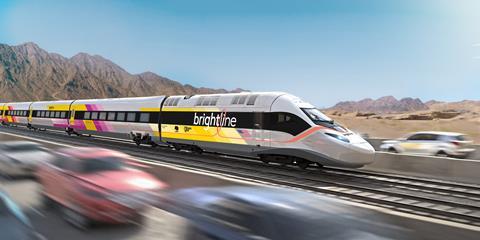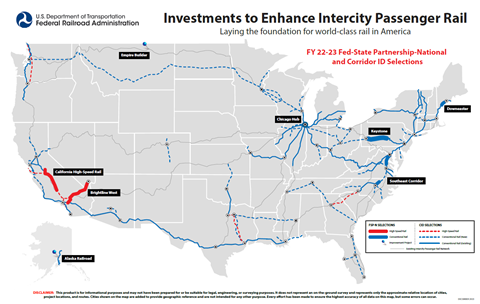
USA: The Federal Railroad Administration has allocated a total of $8·2bn of Federal-State Partnership for Intercity Passenger Rail programme 2022-26 funding to 10 projects, and selected 69 proposals for further development.
| Federal-State Partnership for Intercity Passenger Rail funding | ||
|---|---|---|
| State | Project | Maximum funding, $m |
| Alaska | ARRC Milepost 190·5 Bridge Replacement Project | 8·2 |
| California | California Inaugural High-Speed Rail Service Project | 3 073·6 |
| Illinois | Chicago Union Station Mail Platform Reactivation Project | 49·6 |
| Illinois | Chicago Union Station Platform Capacity Expansion & Trainshed Ventilation Improvements Project | 44·0 |
| Maine | Downeaster Corridor Track Improvement Project | 27·5 |
| Montana | Malta Corridor Operational Enhancement Project | 14·9 |
| Nevada | Brightline West High-Speed Intercity Passenger Rail System Project | 3 000·0 |
| North Carolina | Raleigh to Richmond (R2R) Innovating Rail Program – Phases IA and II | 1 095·6 |
| Pennsylvania | Pennsylvanian Rail Modernisation Project | 143·6 |
| Virginia | Transforming Rail in Virginia Phase 2 Project | 729·0 |
The announcement on December 8 came a month after the FRA announced $16·4bn in funding for 25 projects along the Northeast Corridor.
The $3bn for the California high speed rail programme will fund six electric trains for testing and use; servicing facilities; design and construction of Fresno station; final design, early works and right-of-way acquisition on the extensions to Merced to Bakersfield; and construction in the Central Valley.
Andy Kunz, President & CEO of the US High Speed Rail Association, said ‘the tide has turned for high-speed rail in America’, and the funding ’represents a milestone in advancing our progress and making us competitive with the 26 nations that currently have fast, clean and safe high-speed trains’.
The funding allocations are ‘another historic step to deliver the passenger rail system that Americans have been calling for’, said Transportation Secretary Pete Buttigieg. ’We’ll deliver America’s first high speed rail on a route between southern California and Las Vegas, complete major upgrades for riders in Virginia, North Carolina, Illinois, Pennsylvania, Maine, Montana and Alaska, and announce a comprehensive plan that makes it easier to expand passenger rail lines in 44 states’.
Corridor ID funding

Corridor Identification & Development programme funding has been awarded to support proposals to upgrade 15 existing routes, add or extend services on 47 routes, and advance seven new high speed rail projects. This aims to create a pipeline of work ready for future investment and implementation.
The Corridor ID programmes includes proposals for
- a high speed rail service in the Cascadia corridor between Oregon, Washington and British Columbia;
- high speed rail services between Dallas and Houston;
- daily, multi-frequency service from Chicago to Indianapolis;
- increased frequencies from Chicago to Milwaukee and the Twin Cities, with extensions to Madison, Wisconsin;
- improved services from Chicago to Detroit, with an extension to Windsor in Canada;
- a comprehensive plan for the Chicago hub and service chokepoints south of Lake Michigan benefiting all corridors and long-distance trains south and east of Chicago;
- a new service between the Twin Cities and Duluth, Minnesota;
- a new service from Fort Collins to Boulder, Denver, Colorado Springs and Pueblo;
- a new service between Phoenix and Tucson;
- a new service connecting Baton Rouge and New Orleans;
- new connections between the Northeast Corridor, northern Delaware and Reading and Scranton;
- expanded connections and increased frequencies on California’s conventional rail network;
- expanded connections and services between Tampa, Jacksonville, Orlando and Miami in Florida;
- a new service between Atlanta and Savanah, and from Atlanta to Nashville and Memphis via Chattanooga;
- restoration of services between Chicago and Seattle through rural communities in North Dakota and Montana that are currently not served by passenger rail.
FRA Administrator Amit Bose said the Bipartisan Infrastructure Law ‘gave us a once-in-a-generation opportunity to think smart and think big about the future of rail in America, and we are taking full advantage of the resources we have to advance world-class passenger rail services nationwide’.

















